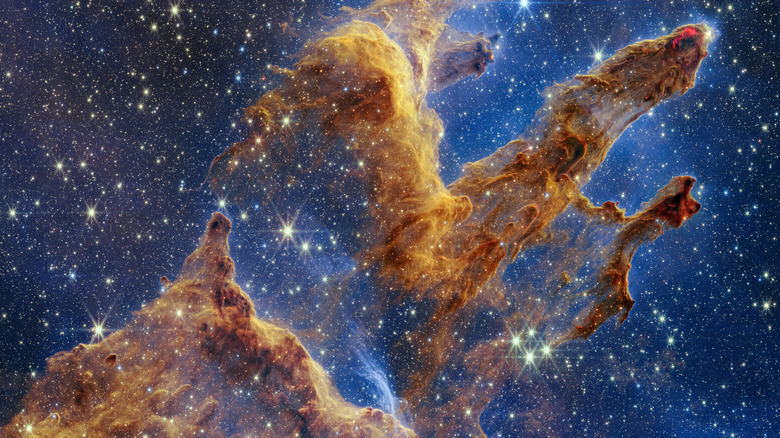James Webb Shows Off The Famous Pillars Of Creation In Stunning Detail
One of the most famous images from space of all time is the Pillars of Creation, an image captured by the Hubble Space Telescope in 1995. Showing an area of the Eagle Nebula, the columns of gas illuminated against a gorgeous backdrop of stars has become one of the iconic images illustrating both the wonders of the cosmos and the power of space telescopes like Hubble. Now, the James Webb Space Telescope has imaged the same region to produce its own version of the stunning spacescape.
The pillars themselves are formed of dust and gas, which are illuminated by the bright young stars burning nearby. As stars form, they give off jets of material which sculpt and shape the dust and gas into distinctive shapes.
This region is full of new stars being born, as the clouds of dust and gas form clumps which eventually collapse under their own gravity to form the building blocks of new stars, called protostars. You can see the bright young stars in the image as those which are glowing brightly, with the distinctive diffraction spikes you see on James Webb images, which are due to the hexagonal shape of the telescope's primary mirror.
Studying this scene can help us learn more about star formation, Webb scientists write: "Webb's new view of the Pillars of Creation will help researchers revamp their models of star formation by identifying far more precise star populations, along with the quantities of gas and dust in the region. Over time, they will begin to build a clearer understanding of how stars form and burst out of these dusty clouds over millions of years."
Looking in the infrared
The Webb image is rather different from the older Hubble image, even though they are of the same target, because the two telescopes look in different wavelengths. Hubble looks primarily in the optical or visible light range, which is the same part of the electromagnetic spectrum that the human eye sees. But Webb looks in the infrared range, which is beyond the red part of the visible light range.
That means the dust structures of the pillars are semi-transparent to Webb because it uses its NIRCam instrument to look in the near-infrared range. This also means that you can see many, many more stars in the Webb image than the Hubble image, because all of the dust and gas block their light in the optical range, but not in the infrared. However, Webb scientists point out that although you can see many stars through the pillars, these are not galaxies. Instead, they are stars in the immediate vicinity of the pillars, and any background galaxies are still blocked off by the dust and gas which lurks between stars, called the interstellar medium.
Looking in the infrared makes it possible to pick out features of the pillars which would be otherwise invisible, like the glow of hydrogen molecules shown in red at the tips of two of the pillars. These molecules are highly energetic because of the jets of material being cast off by young stars around them.
